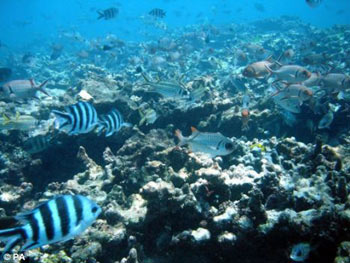You are hereArchive
Archive
Japan Urges Limit on Cell Phone Use by Kids
(quote)
TOKYO (AFP) — A Japanese government panel called on parents and schools Monday to help limit the use of mobile phones by children to prevent them from accessing "harmful" information on websites. The advisory council on education made the proposal to Prime Minister Yasuo Fukuda as children become more prone to crimes involving dating websites and bullying on Internet school bulletin boards. The panel said it would urge "parents, schools and other people concerned to cooperate in preventing elementary and junior high school students from using mobile phones unless it is necessary." It called for limiting mobile phone use just to calls.
These measures are necessary to "protect children from harmful information and other negative influence involving the use of mobile phones" including "crimes and bullying," the report said. Press reports have linked some crimes by children to dating websites. "It is true that the use of mobile phones causes various problems," Fukuda told reporters. "I think the panel has made timely discussions on the problem." He added: "First of all, I wonder if there is any need for children to possess mobile phones."
While about a third of Japanese primary school students aged 7-12 use mobiles, by the time they get to high school that figure rises to 96 percent, according to a government survey last December. There are fears for students' safety as only about one percent of them have blocks on potentially harmful material, meaning they could reveal personal information, making them prey for fraudsters and pedophiles. But even on protected sites such as school bulletin boards, bullies are able to anonymously post comments without teacher oversight or intervention.
(unquote)
Images Courtesy of AFP and blog.pcnews.ro


Original Source: AFP
Inspiration for 'Family Circus' Mommy Passes Away at 82
(quote)
PHOENIX (AP) — Thelma Keane, the inspiration for the Mommy character in the long-running "Family Circus" comic created by her husband, Bil Keane, has died. She was 82. She died Friday of Alzheimer's disease, the family said.
"Family Circus," which Keane began drawing in 1960, depicts the good-humored life of two parents and their four children. It is now featured in about 1,500 newspapers. "She was the inspiration for all of my success," Bil Keane, 85, told The Associated Press from his home in Paradise Valley on Sunday. "When the cartoon first appeared, she looked so much like Mommy that if she was in the supermarket pushing her cart around, people would come up to her and say, 'Aren't you the Mommy in 'Family Circus?' and she would admit it."
Bil and Thelma "Thel" Keane met during World War II in the war bond office in Brisbane, Australia. She was a native Australian working as an accounting secretary, and Bil worked next to her as a promotional artist for the U.S. Army. "I had this desk alongside the most beautiful Australian 18-year-old girl with long brown hair," Bil Keane said. "And I got up enough nerve to ask her for a date." The two married in 1948 and moved to Bil Keane's hometown of Philadelphia. They had five children and moved to the Phoenix suburb of Paradise Valley in 1958.
Not only was Thelma Keane the inspiration for the always-loving and ever-patient comic character also named Thel, but she worked full-time as her husband's business and financial manager. Her family says she was the reason Bil Keane became one of the first syndicated newspaper cartoonists to win back all rights to his comic. "There was nothing that I did in the cartoon world or in the business world that she wasn't the instigator of, and she certainly deserves all the credit that I get credit for," Bil Keane said. "The losing of Thel is a heartbreaking thing for me," he said. "However, it makes me realize how important she was to my worldly success, and I know where she is now, I feel that she's still helping me and probably giving me the inspirations you can only get from an angel in heaven."
(unquote)


Original Source: AP
Euro, Franc, Krona to Benefit From Oil, U.S. dollar ranks bottom
Original Source: Bloomberg
(quote)
May 26 (Bloomberg) -- Currencies in Europe will benefit from record oil prices because of the region's energy efficiency, exports to oil-producing nations and vigilance against inflation, according to Barclays Capital. The euro, the British pound, the Swiss franc, the Swedish krona and the Norwegian krone should perform "relatively well" as oil prices rise, wrote David Woo, global head of foreign exchange strategy in London at the bank, the third-biggest currency trader. The U.S. dollar ranks bottom in terms of potential performance as energy prices climb, it said. "Europe is well positioned in the new paradigm, the U.S. is not," Woo wrote in a research note dated May 23.
The dollar slid as much as 8.9 percent to a record low against the euro this year as losses from the subprime mortgage collapse threatened to send the U.S. economy into a recession. At the same time, oil futures have soared to a record as a crude producers sought higher dollar prices to compensate for lower import revenues, according to Barclays Capital. This has created a "vicious circle'' where high energy prices increase the U.S. trade deficit and make other central banks reluctant to lower interest rates, leading to further dollar declines, Barclays Capital said. The euro bought $1.5757 at 5:23 p.m. in Tokyo, little changed from late in New York on May 23. It rose to $1.6019 on April 22, the highest since the common European currency's introduction in January 1999.
The U.S., Canadian, New Zealand and Australian score poorly in terms of their intensity of energy use because of their dispersed populations and focus on manufacturing or commodity industries, Barclays said. European economies are more densely populated, service-orientated and energy efficient, it said. Oil consumption accounts for less than 2 percent of nominal gross domestic product in Norway, Switzerland, the U.K. and Sweden in 2006, compared with more than 3.5 percent in the U.S. and Canada, the report showed. "The U.S. is the world's third-largest oil producer but because of the high energy intensity of its economy, its petroleum trade deficit is not much smaller than the eurozone, which produces no oil," Woo wrote. Japan and Switzerland may also suffer deteriorating trade balances as oil prices rise, the report said. Crude oil for July delivery rose by 96 cents to $133.15 a barrel in after-hours electronic trading on the New York Mercantile Exchange. It reached $135.09 on May 22, the highest since trading began in 1983.
(unquote)
Next month marks the tenth anniversary of the European Central Bank, guardian of the euro, which itself will turn ten thereafter.
Images courtesy of AP Photo/Haraz N. Ghanbari and AFP


Military Jokes, Cartoon - being in the Air Force means moving frequently as carrying home where they go
Being in the Air Force means having to move frequently. When some friends of ours were transferred to a nearby base, the local TV station interviewed them for a human-interest story. The interviewer asked their five-year-old daughter how she felt about settling into a new home. She calmly replied, "Oh, we carry our home with us – we just have to find a house to put it in."
-- Alan Whittle
My friend, a Marine, didn't care that his trip to the shooting range had been canceled, but he was put off that his physical exam was still on.
"Should it bother me," he asked, "that they don't seem to care how well I can shoot, but they are interested in how fast I can run?"
-- Dawn Gutierrez

Original Source Reader’s Digest
Rising Acidity in World’s Ocean Waters 100 Years Earlier than Predicted
(quote)
Climate models predicted it wouldn't happen until the end of the century. So Seattle researchers were stunned to discover that vast swaths of acidified sea water are already showing up along the Pacific Coast as carbon dioxide from power plants, cars and factories mixes into the ocean. In some places, including Northern California, the acidified water was as little as four miles from shore.
"What we found ... was truly astonishing," said oceanographer Richard Feely, of the National Oceanic and Atmospheric Administration's Pacific Marine Environmental Laboratory in Seattle. "This means ocean acidification may be seriously impacting marine life on the continental shelf right now." The phenomenon is an aspect of global warming scientists are just beginning to understand.
Acidified ocean water can be fatal to some fish eggs and larvae. It also interferes with the formation of shells and skeletons, harming corals, clams, oysters, mussels and the tiny plankton that are the basis of the marine food web. "Their shells dissolve faster than they are able to rebuild them," said Debby Ianson, an oceanographer at Fisheries and Oceans Canada and a co-author of the study published today in the online journal Science Express.
Since the Industrial Revolution, when humans began pumping massive amounts of carbon dioxide into the atmosphere, the oceans have absorbed 525 billion tons of the greenhouse gas, Feely estimates. That's about a third of the man-made emissions during that time. By reducing the amount of carbon dioxide in the atmosphere, the oceans have blunted the temperature rise due to global warming. But they've suffered for that service, with a more than 30 percent increase in acidity.
"This is another example where what's happening in the natural world seems to be happening much faster than what our climate models predict," said Carnegie Institution climate scientist Ken Caldeira, whose work suggested it would be nearly 100 years before acidified water was common along the West Coast. And there's worse to come, the scientists warn. The acidified water upwelling along the coast today was last exposed to the atmosphere about 50 years ago, when carbon-dioxide levels were much lower than they are now. That means the water that will rise from the depths over the coming decades will have absorbed more carbon dioxide, and will be even more acidic. "We've got 50 years' worth of water that's already left the station and is on our way to us," study co-author Hales said. "Each one of those years is going to be a little bit more corrosive."
(unquote)
Images courtesy of Dana Greeley & Simone Alin, PMEL, and Daily Mail


Original Source: Seattle Times
NASA Mars Probe Prepares for Risky Landing
Original Source: BBC News
(quote)
The Phoenix lander is due to touch down on Monday in the far north of the Red Planet, after a 423-million-mile journey from Earth. The probe is equipped with a robotic arm to dig for water ice thought to be buried beneath the surface. Scientists say the mission should give the clearest indication yet of whether Mars could once have harbored life.
The final seven minutes of the probe's ten-month journey is regarded as the riskiest part of the mission. After it enters the top of the Martian atmosphere at nearly 5.7km/s (13,000 mph), the probe must perform a series of maneuvers to come safely to rest. It will release a parachute, use pulsed thrusters to slow to a fast walking speed, then come to a halt on three legs. If all goes to plan, the Phoenix lander will reach the surface of Mars at 0053 BST (1953 EDT) on May 26. Nasa controllers will know in about 15 minutes whether the attempt has been successful.
Landing on Mars is a notoriously tricky business. Of the 11 missions that have tried to land probes on Mars since 1971 - only five have succeeded. Phoenix is an apt name for the current mission, as it rose from the ashes of two previous failures. In September 1999, the Mars Climate Orbiter spacecraft crashed into the Red Planet following a navigation error caused when technicians mixed up "English" (imperial) and metric units. A few months later, another Nasa spacecraft, the Mars Polar Lander (MPL), was lost near the planet's South Pole. Phoenix uses hardware from an identical twin of MPL, the Mars Surveyor 2001 Lander, which was cancelled following the two consecutive failures. The probe was launched on 4 August 2007 on a Delta II rocket from Cape Canaveral Air Force Station in Florida.
(unquote)



Fun, Fitness, and Games - Shigeru Miyamoto’s Newest Wii Fit
Original Source: New York Times
(quote)
IT’S O.K. to liken Shigeru Miyamoto to Walt Disney. When Disney died in 1966, Mr. Miyamoto was a 14-year-old schoolteacher’s son living near Kyoto, Japan’s ancient capital. An aspiring cartoonist, he adored the classic Disney characters. When he wasn’t drawing, he made his own toys, carving wooden puppets with his grandfathers’ tools or devising a car race from a spare motor, string and tin cans. Even as he has become the world’s most famous and influential video-game designer — the father of Donkey Kong, Mario, Zelda and, most recently, the Wii — Mr. Miyamoto still approaches his work like a humble craftsman, not as the celebrity he is to gamers around the world.
Perched on the end of a chair in a hotel suite a few dozen stories above Midtown Manhattan, the preternaturally cherubic 55-year-old Mr. Miyamoto radiated the contentment of someone who has always wanted to make fun. And he has. As the creative mastermind at Nintendo for almost three decades, Mr. Miyamoto has unleashed mass entertainment with a global breadth, cultural endurance and financial success unsurpassed since Disney’s fabled career.
Mario, the mustached Italian plumber he created almost 30 years ago, has become by some measures the planet’s most recognized fictional character, rivaled only by Mickey Mouse. As the creator of the Donkey Kong, Mario and Zelda series (which have collectively sold more than 350 million copies) and the person who ultimately oversees every Nintendo game, Mr. Miyamoto may be personally responsible for the consumption of more billions of hours of human time than anyone around. In the Time 100 online poll conducted this spring, Mr. Miyamoto was voted the most influential person in the world.
But it isn’t just traditional gamers who are flocking to Mr. Miyamoto’s latest creation, the Wii. Eighteen months ago, just when video games were in danger of disappearing into the niche world of fetishists, Mr. Miyamoto and Satoru Iwata, Nintendo’s chief executive, practically reinvented the industry. (Mr. Miyamoto’s full title is senior managing director and general manager of Nintendo’s entertainment analysis and development division.) Their idea was revolutionary in its simplicity: rather than create a new generation of games that would titillate hard-core players, they developed the Wii as an easy-to-use, inexpensive diversion for families (with a particular appeal to women, an audience generally immune to the pull of traditional video games). So far the Wii has sold more than 25 million units, besting the competition from Sony and Microsoft.
Last week Nintendo released its new Wii Fit system in North America, a device that hopes to make doing yoga in front of a television screen almost as much fun as driving, throwing, jumping or shooting in a traditional game. Though there were no hard sales figures available as of Tuesday, there were reports of stores across the country selling out of Wii Fit.
(unquote)




















